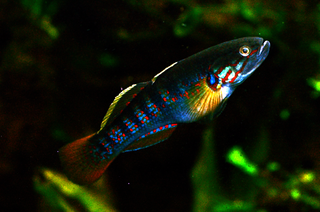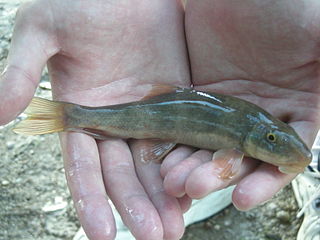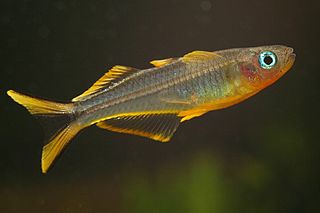
Poeciliidae are a family of freshwater ray-finned fishes of the order Cyprinodontiformes, the tooth-carps, and include well-known live-bearing aquarium fish, such as the guppy, molly, platy, and swordtail. The original distribution of the family was the Southeastern United States to north of Río de la Plata, Argentina, and Africa, including Madagascar. Due to release of aquarium specimens and the widespread use of species of the genera Poecilia and Gambusia for mosquito control, though, poeciliids can today be found in all tropical and subtropical areas of the world. In addition, Poecilia and Gambusia specimens have been identified in hot springs pools as far north as Banff, Alberta.

Clupeiformes is the order of ray-finned fish that includes the herring family, Clupeidae, and the anchovy family, Engraulidae. The group includes many of the most important forage and food fish.

Carpet sharks are sharks classified in the order Orectolobiformes. Sometimes the common name "carpet shark" is used interchangeably with "wobbegong", which is the common name of sharks in the family Orectolobidae. Carpet sharks have five gill slits, two spineless dorsal fins, and a small mouth that does not extend past the eyes. Many species have barbels.

Acantopsis is a genus of freshwater fishes, commonly known as horseface loaches or banana-root fishes, in the family Cobitidae. Fishes of the genus Acantopsis inhabit sandy riverbeds throughout Southeast Asia and are most diverse in the Mekong River in Thailand, Laos, and Cambodia wherein five species are known to occur. The common horseface loach, A. rungthipae, is popular in the aquarium trade.

Eleotridae is a family of fish commonly known as sleeper gobies, with about 34 genera and 180 species. Most species are found in the tropical Indo-Pacific region, but there are also species in subtropical and temperate regions, warmer parts of the Americas and near the Atlantic coast in Africa. While many eleotrids pass through a planktonic stage in the sea and some spend their entire lives in the sea; as adults, the majority live in freshwater streams and brackish water. One of its genera, Caecieleotris, is troglobitic. They are especially important as predators in the freshwater stream ecosystems on oceanic islands such as New Zealand and Hawaii that otherwise lack the predatory fish families typical of nearby continents, such as catfish. Anatomically, they are similar to the gobies (Gobiidae), though unlike the majority of gobies, they do not have a pelvic sucker.

Rasbora is a genus of fish in the family Cyprinidae. They are native to freshwater habitats in South and Southeast Asia, as well as southeast China. A single species, R. gerlachi, is only known from an old specimen that reputedly originated from Africa (Cameroon), but this locality is considered doubtful. They are small, up to 17 cm (6.7 in) long, although most species do not surpass 10 cm (4 in) and many have a dark horizontal stripe.
Salangidae, the icefishes or noodlefishes, are a family of small osmeriform fish, related to the smelts. They are found in Eastern Asia, ranging from the Russian Far East in the north to Vietnam in the south, with the highest species richness in China. Some species are widespread and common, but others have relatively small ranges and are threatened. Depending on species, they inhabit coastal marine, brackish or fresh water habitats, and some are anadromous, only visiting fresh water to spawn.

The stream catfishes comprise the family Akysidae of catfishes.

Catostomus is a genus of fish belonging to the family Catostomidae, commonly known as suckers. This genus of fish usually lives in freshwater basins. Most members of the genus are native to North America, but C. catostomus is also found in Russia.
Pseudomystus is a genus of catfishes of the family Bagridae.
Pseudobagarius is a genus of catfishes of the family Akysidae.

Clupeoides is a genus of sprats that occur in rivers in Southeast Asia. There are currently four recognized species in the genus.

Clupeonella is a genus of fish in the family Ehiravidae. They are widespread in the fresh and brackish waters of the Caspian Sea and Black drainages.

Pseudomugil is a genus of fish in the subfamily Pseudomugilinae endemic to Australia and New Guinea, where they are found in freshwater rivers and streams and bodies of brackish water.
Rasbora johannae is a species of ray-finned fish in the genus Rasbora. It is endemic to Kalimantan. This species reaches a length of 3.8 cm (1.5 in).
Gilchristella aestuaria, the Gilchrist's round herring or estuarine round-herring, is a member of the family Ehiravidae that occurs off the coasts of Southern Africa. It is the only species in its genus, which was named for John Dow Fisher Gilchrist (1866–1926).
Gerald Robert "Gerry" Allen is an American-born Australian ichthyologist. His career began in 1963, when he spent a semester at the University of Hawaii, where he also received a PhD in marine zoology in 1971. In 1972, Allen wrote his doctoral thesis on the systematics and biology of the anemone fish.
Psilorhynchus olliei is a freshwater ray-finned fish, from Kyari Chaung, Ayeyarwady drainage in Myanmar. This species reaches a length of 5.4 cm (2.1 in).

Ehiravidae is a family of clupeiform fishes. It is now recognized by FishBase as a family in its own right; it had been considered to be a subfamily of Clupeidae. It contains eleven extant genera.











